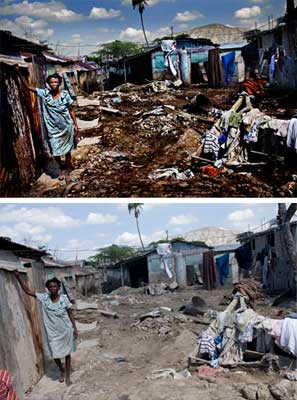An article this week on Stinky Journalism, Danielle Mastropiero's "Photoshopped Images Booted from Press Photo Contest," calls to mind a couple of other similar incidents in recent memory: first, Adnan Hajj's laughably bad Photoshop manipulations of smoke plumes over Beirut during Israel's summer '06 bombing campaign; and second, Iran's equally laughable manipulation of publicity photos from their summer '08 test missile test launch.

Image source: Stinky Journalism.org
Click on 'voteringen' in the menu of this Flash-animated comparison of Christensen's submitted photographs, their RAW files, and the Photoshop auto-corrections.
The ethical question of representation in these cases branches out beyond simple questions of technique. My gut reaction is that these questions of authenticity in reportage only seem to crop up in depictions of 'the Other'--realities of Haiti, Lebanon, and Iran being the examples I've chosen--but other cases come to mind as well, such as the indignation over unretouched portraits of Gov. Palin (for the cover of Newsweek) and Sen. McCain (for the cover of Atlantic Monthly).
As far as pedagogy is concerned, these cases of photographic manipulation provide an object lesson in the subtleties of plagiarism that are harder to convey than taking credit for another's work. Digital media and tools of manipulation have already deposited this comfortable academic principle in a vague, soupy ethical context. Still, how one represents the works (or realities) of another person opens the door to the specter of plagiarism. A careful exposition and discussion of these cases of manipulation and reportage might help to elucidate these vague or complicated situations for the average undergraduate student.
Recent comments
2 years 29 weeks ago
2 years 44 weeks ago
2 years 44 weeks ago
2 years 50 weeks ago
3 years 4 weeks ago
3 years 4 weeks ago
3 years 4 weeks ago
3 years 6 weeks ago
3 years 6 weeks ago
3 years 6 weeks ago